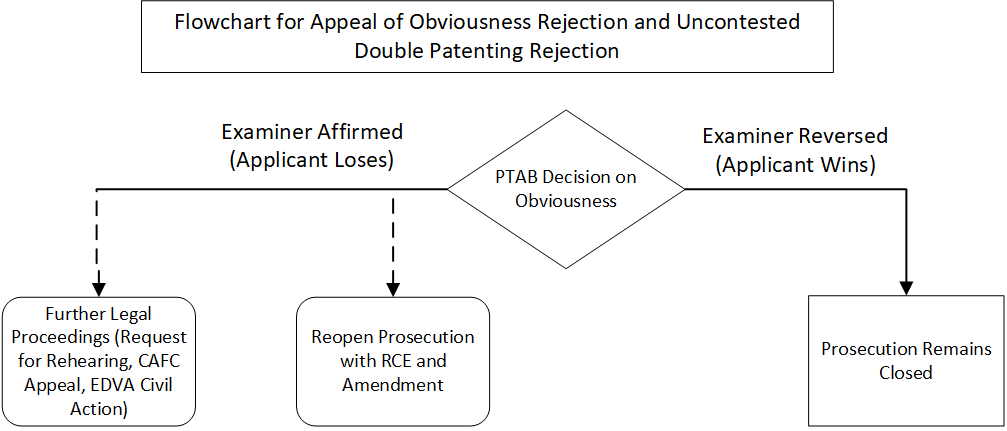After our extensive discussion of Terminal Disclaimers, we now turn our attention to the issue raised during Study Group Session 13 on November 26, 2020. During that session, we discussed Ex parte Hirose, stemming from US Serial No. 15/879,180 (“the ‘180 application”).
In that prosecution, the Non-Final Rejection of January 22, 2019, included a double patenting rejection and an obviousness rejection. The Applicant filed a Terminal Disclaimer (TD) to remove the double patenting rejection. The Applicant then began the appeal process, without filing a substantive response to the Non-Final Rejection.
Why did the Applicant file a TD instead of appealing the double patenting rejection? Simply, the Applicant must have had no plans to contest the double patenting rejection on the then-current claims. So, to understand the TD, we should consider the potential outcomes for an appeal with both an obviousness rejection and an uncontested double-patenting rejection.

Let’s start on the left side of the chart. If the PTAB affirms the obviousness rejection, then the Applicant must either (a) pursue further legal proceedings or (b) reopen prosecution with an RCE and a claim amendment.
For several reasons, Applicants rarely pursue further legal proceedings. Thus, it is significantly more likely the unsuccessful Applicant reopens prosecution with a claim amendment to address the obviousness rejection. In this situation, the Examiner must reassess the double patenting rejection in view of the amended claim.
These options do not suggest any reason for filing the TD. So, the Applicant’s reason must lie on the right side of our chart. That is, the Applicant must be considering the potential reversal of the obviousness rejection.
On the right side of the chart, if the PTAB reverses the obviousness rejection, then prosecution remains closed. The reason is that, although the obviousness rejection is removed, the double patenting rejection is sustained.
Reopening prosecution requires a Request for Continued Examination (RCE). An RCE had already been filed in this prosecution, so this subsequent RCE would require the higher $2000 fee.
So, it seems like a great idea to file the TD before the appeal. By doing so, the Applicant can avoid a situation where the Applicant must incur a $2000 government fee simply to file a TD.
However, no such RCE is required. MPEP 1214.06 I states, “If the application includes a non-statutory double patenting rejection which was affirmed by the Board or a provisional rejection that was not addressed by the Board, the applicant may file a proper terminal disclaimer . . . to overcome the [double patenting] rejection.”
As a result, it might have been unnecessary to file the TD before the appeal. By filing the TD, the Applicant lost an opportunity to have the PTAB consider the propriety of the double patenting rejection.
And if the PTAB affirmed the obviousness rejection, the Applicant would have amended the claims to address the obviousness rejection. Indeed, the actual prosecution followed this path. The Applicant could have traversed the double patenting rejection on these amended claims.
In any case, our free, biweekly US Prosecution Study Group is open to non-US patent professionals. The dialogue and the slides are translated into Japanese (日本語). The live sessions are hosted on Zoom, and the recordings are archived privately on YouTube. Please email us if you are interested in attending or viewing a session.